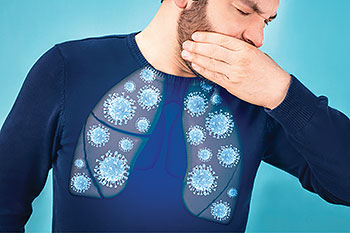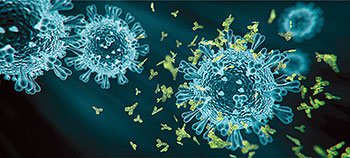 John fell ill with the novel Coronavirus in June 2020. For the next two months after he “recovered”, he was so short of breath that he had to wear oxygen day and night, and still couldn’t walk more than 100 feet without taking a rest. His daily 5-mile run was out of the question. He took naps every afternoon because any exertion at all wiped him out. He took a prescription drug every night to help him cope with panic attacks triggered by gasping for air. He developed diabetes. The steroids he was prescribed to help him breathe actually made his breathing worse. Needless to say, he had to take a leave of absence from his work as a law enforcement officer. John fell ill with the novel Coronavirus in June 2020. For the next two months after he “recovered”, he was so short of breath that he had to wear oxygen day and night, and still couldn’t walk more than 100 feet without taking a rest. His daily 5-mile run was out of the question. He took naps every afternoon because any exertion at all wiped him out. He took a prescription drug every night to help him cope with panic attacks triggered by gasping for air. He developed diabetes. The steroids he was prescribed to help him breathe actually made his breathing worse. Needless to say, he had to take a leave of absence from his work as a law enforcement officer.
When John learned that other people had overcome Long-COVID, he began to have hope again. He was ready to try anything. Fortunately, by targeting the underlying causes of his prolonged dysfunction, he was back to work two weeks after his first appointment.
 Sharon is a nurse practitioner who one day became short of breath (couldn’t walk more than 20 steps at a time), developed a cough, lost her sense of taste, and developed itching all over her body. She began having difficulty remembering words and forming meaningful sentences. She suffered from headaches, nausea, dizziness, profound fatigue, chest pains, numbness in her hands, and swelling in her hands and feet. She ended up quitting her job because she never knew if she would be able to go to work on a given morning until she woke up. She became depressed and anxious, having lost hope of any recovery. Sharon is a nurse practitioner who one day became short of breath (couldn’t walk more than 20 steps at a time), developed a cough, lost her sense of taste, and developed itching all over her body. She began having difficulty remembering words and forming meaningful sentences. She suffered from headaches, nausea, dizziness, profound fatigue, chest pains, numbness in her hands, and swelling in her hands and feet. She ended up quitting her job because she never knew if she would be able to go to work on a given morning until she woke up. She became depressed and anxious, having lost hope of any recovery.
Sharon saw nine different medical specialists looking for solutions. She had been to the ER twice. One of her specialists prescribed 17 times the normal dose of allergy medicine in an attempt to make her itchy rashes bearable. Repeated courses of steroids and antihistamines had not helped. Another specialist had her taking a leprosy drug off-label, to no avail.
Sharon could not stop scratching herself during her first appointment. Fortunately, like John, Sharon was able to start a personalized recovery protocol that addressed the underlying causes of her many symptoms and began to obtain relief within days.
Unlike Sharon, the overwhelming majority of Americans experience only minor if any reactions to the COVID shots. For those few who do not react well to the injections, their world can be turned upside down overnight. Sharon’s symptoms began the day after her shot. Others may not react for days or weeks, while most do not react at all.
John and Sharon have two things in common: Spike protein and susceptibility.
Spike protein, a product of both the virus and the shot, has a number of important consequences, including immune overreaction, excessive inflammation, inappropriate clotting, and brain dysfunction.
 Your immune system was designed to have numerous checks and balances. When a threat (such as a virus or bacteria) is encountered, the immune system mounts a rapid response to neutralize the threat and then returns to surveillance mode. The delicate balance between attack mode and surveillance mode enables the immune system to eliminate threats with minimal collateral damage, i.e. damage to your own body. Your immune system was designed to have numerous checks and balances. When a threat (such as a virus or bacteria) is encountered, the immune system mounts a rapid response to neutralize the threat and then returns to surveillance mode. The delicate balance between attack mode and surveillance mode enables the immune system to eliminate threats with minimal collateral damage, i.e. damage to your own body.
By contrast, the Spike protein was designed to force the immune system to stay in attack mode indefinitely. You have no doubt heard of cytokine storm. Cytokines protect us every day from potentially deadly bugs. But cytokines have to be kept on a short leash. When Spike proteins cut that leash, cytokines change from being lifesavers to becoming killers. People who are unable to shut down or at least calm down attack mode end up dying at the hands of their own immune systems.
This brings us to the second problem John and Sharon have in common: Susceptibility. The average person who becomes infected with COVID-19 or receives one of the shots has a largely unremarkable response. But a few react badly, some even dying. There are any number of factors that predispose some people to not handling Spike protein as well as others.
For example, doctors in Wuhan, China, were the first to observe and report that the single biggest difference between life and death at the beginning of the pandemic was a person’s pre-existing vitamin D level. Getting your level checked and optimized is the easiest thing you can do to reduce your own risk dramatically. There are other factors you can modify with appropriate medical assistance, such as excess body fat, hidden infections, high blood pressure, high blood sugar, cardiovascular disease, cancer, autoimmune diseases, and just about any other source of inflammation you can think of.
Once you are already behind the eight ball, however, getting your health back takes more than modifying your risk factors, which aren’t going to change overnight anyway. At Prestige Wellness Institute, we employ a number of tools to shut down the cytokine storm, reduce inappropriate inflammation, increase energy, and restore proper brain function as quickly as possible. If you have had the misfortune of suffering from Long-COVID or a reaction to one of the COVID shots, there is hope. You can enjoy life again. When you’re ready, call (435) 210-0184 to get back on the road to health.
|